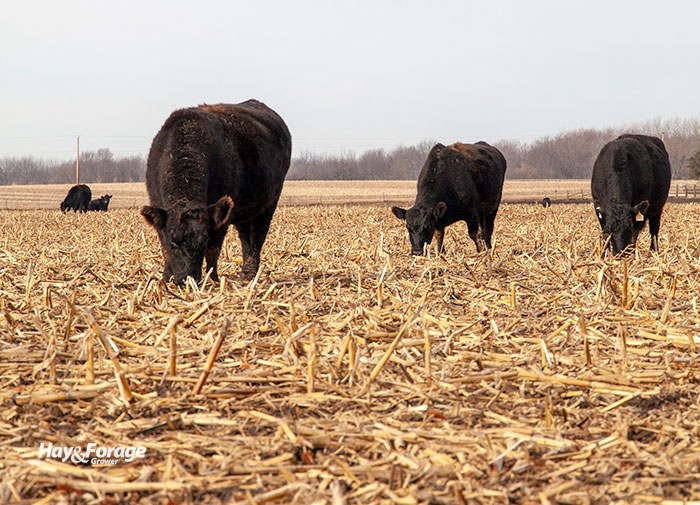
Pastures change during this time of year. No longer are they lush and rapidly growing. Rather, pastures are often comprised of stockpiled perennial forages; cereal grains, such as oats, planted in late summer; or cornstalks.
Wherever corn is grown for grain, which encompasses over 82 million acres across the U.S., the opportunity to utilize corn residue as a grazing resource exists. Aaron Berger, a University of Nebraska Extension educator, notes that there is more than twice the number of cornstalk acres available in his state than what is needed for their 2 million beef cows.
Berger offers these key considerations for livestock producers who plan to utilize cornstalks as a late fall/early winter forage resource:
Scout fields prior to grazing to determine the amount of corn present and to look for grain piles that could cause overconsumption of grain. This can result in severe acidosis, lameness, bloat, or even cattle death. Berger suggests that if there is more than 8 to 10 bushels of ears of corn per acre on the ground, a grazing strategy to control corn intake will need to be used. Typically, there is less than 1 bushel per acre of ear drop.
Determine stocking rates based on corn bushel yield per acre and the average weight of cattle that will be grazing. The Corn Stalk Grazing Calculator is an Excel spreadsheet that can be used to calculate this and is available for download or as a cellphone app.
A quick way to estimate grazing days per acre available for a 1,200-pound nonlactating cow is to take the corn bushel yield and divide by 3.5. For example, 180 bushels per acre yield divided by 3.5 equals 51 grazing days per acre.
Forage quality varies over time. Initially, the quality of consumed forage/grain starts high at approximately 70% total digestible nutrients (TDN), and then it declines to a low of 45% TDN by the end of the grazing period. “If cows have husk and leaf to select, they will consume a diet that is 52% to 55% TDN and about 5% to 5.5% crude protein,” Berger notes. “The rate of quality decline is dependent on stocking rate and environmental factors, such as moisture and field conditions.”
Cool, dry weather conditions in the fall and winter will maintain forage quality for a longer period of time. Conversely, wet, warm, and muddy conditions will result in a faster deterioration of leaves and husks.
Diet needs vary with livestock class. Mature, nonlactating, spring-calving cows with a body condition score of 5 or better will not need protein supplement when grazed at recommended stocking rates.
First-calf heifers, 90 days prior to calving, will need protein and energy supplementation to meet nutrient requirements. Berger suggests feeding 3.5 pounds per head per day of dried distillers grains to meet this need.
Fall-calving cows will need additional protein and energy to meet nutrient requirements. Cows that are less than three months since calving will need 4.5 pounds per head per day of a supplement that is at least 30% protein and 90% TDN on a dry matter basis. Feeding 5 pounds per head per day of dried distillers grains would meet this need.
Weaned calves that are grazing cornstalks with a targeted gain of 1 pound per day will need to be fed an energy and protein supplement. Research has demonstrated that dried distillers grains fed at 2 pounds per head per day when calves are grazing cornstalks will usually meet this target gain.
Weather matters. Deep snow and ice can severely limit the ability of cattle to graze cornstalks. Berger recommends having a backup plan and other feed resources available to meet cattle needs when weather inhibits access to the corn residue.
“Cornstalks are an excellent, economical resource for late fall and winter grazing,” Berger concludes.

